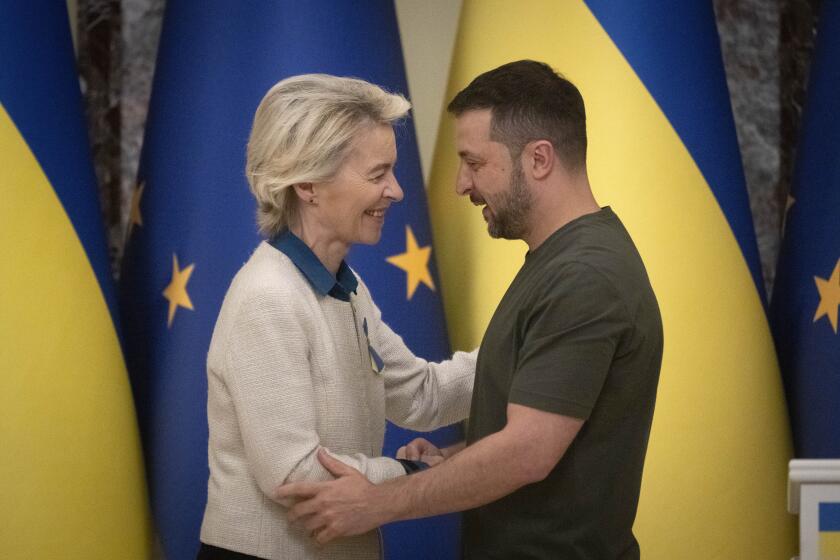Hold the line
FEW TOWNS have been advertised so relentlessly and ostentatiously as Tall Afar, a city in Iraq’s Nineveh province. The story of Tall Afar, which the U.S. Army cleared and pacified late last year, has become a staple of Bush administration rhetoric -- so much so that, last week, the president devoted an entire address to the remote outpost’s lessons.
Having recited what counts, to the media at least, as a familiar catalog of Tall Afar’s achievements, President Bush concluded that “by turning control of these cities over to capable Iraqi troops and police, we give Iraqis confidence that they can determine their own destiny.”
The date for handing off the city to Iraqi security forces has in fact been moved up, as the White House intends to draw down troop levels in Iraq to 100,000. If anything, however, Tall Afar shows the folly of doing so.
Having spent part of January there, I do not doubt that the town amounts to a genuine success story. Even from the parapets of Tall Afar’s centuries-old Ottoman castle, a visitor gleans evidence of real progress. After assaulting the city and putting a halt to the gruesome depredations by insurgents, Washington poured millions of dollars into Tall Afar, and the 3rd Armored Cavalry Regiment launched 150 infrastructure and cleanup projects.
It also locked the place down, establishing 29 patrol bases throughout Tall Afar, stationing Abrams tanks at intersections and rebuilding from scratch the local security forces. Most important, it planted itself directly at the heart of a once-hostile population center, establishing the Americans as an essential buffer between the town’s feuding sects.
None of which is to say that Tall Afar’s murderous rivalries have been completely subdued. An exchange of gunfire that erupted around me turned out to be a Sunni-dominated police unit and a Shiite-dominated army unit firing on one another. But compared to the open warfare before the Americans arrived, the skirmish merely offered a preview of what would come in the U.S. Army’s absence.
In the event of such a withdrawal, Sheik Abdullah Al Yawar, one of the province’s most powerful Sunnis, told me that “there will be rivers of blood.”
In his speech last week, Bush made much of a letter that the mayor of Tall Afar sent the 3rd Armored Cavalry Regiment praising its members for liberating the city. What the president neglected to mention, and what the mayor never tires of mentioning, is that he sent a letter to Bush too -- pleading for the Americans to stay put.
The administration, needless to say, has no intention of doing so, either there or anywhere else in Iraq. No doubt the Bush team’s inclination to reduce U.S. visibility is a response mostly to political rather than strategic imperatives. Nor are the two motives inherently incompatible.
With the belated discovery that the United States has become ensnared in a guerrilla war, the war’s managers have encouraged the military to proceed with a “light footprint” (a phrase that has become canonical in Washington) and to focus on counterinsurgency -- where troop numbers count for much less than tactical finesse -- rather than big-unit operations.
The problem is that the gravest threat to Iraq today comes not from the insurgency but from looming civil war. Unlike an insurgency, in which U.S. troop concentrations tend to invite more problems than they solve, when it comes to keeping local belligerents from one another’s throats, those troops offer the only solution.
In Tall Afar, it was only the Americans who could rein in the brutal Shiite police. It was only the Americans who could battle the insurgency and at the same time extend a hand to Sunni residents. And it was only the Americans who could play the role of honest broker, manning the fault lines between the city’s tribes and sects.
As for Defense Secretary Donald Rumsfeld and other administration officials who believe that U.S. forces have more urgent priorities than to prevent Iraq’s civil strife from exploding into a full-blown civil war, they’d do well to cast a glance backward to the aftermath of the Feb. 22 bombing of the Golden Mosque in Samarra. Even as Iraq descended deeper than ever before into a horror show, U.S. forces mostly hunkered down at their base camps. Unchecked chaos was the result.
But then, the administration knew it would be. Exactly the same thing occurred in Tall Afar two years earlier. Before they retook the city, the Americans, with only 400 soldiers patrolling the region, essentially surrendered it in 2004. Sectarian killings, atrocities and sheer mayhem followed this earlier U.S. withdrawal -- and therein lies the true lesson of a model village.
More to Read
Sign up for Essential California
The most important California stories and recommendations in your inbox every morning.
You may occasionally receive promotional content from the Los Angeles Times.










